
The Fairfield yard on the Clyde at Govan produced these two very similar passenger and cargo-liners in 1948/49. Bibby Line was famous for its four masted passenger and cargo-liners, but in this new pair the passenger accommodation was drastically reduced to 76 First Class passengers. A political delegation from Burma had gone to London in early 1947 to obtain a promise of independence for the proud Burmese races and people, and Yangon (Rangoon) became the capital of the Union of Burma on 4th January 1948 when the country regained its independence from the British Empire, a very much cherished ambition. The first Leicestershire was completed in 1909 of 8,059 grt with good accommodation for 229 First Class passengers, and the first Warwickshire was completed in 1902 of 7,975 grt with good accommodation for 203 First Class passengers. The pair under review here were the second of these names in the Bibby Line fleet.

Bibby Line To Burma
The Bibby family began their famous trade to Rangoon in 1889, with the passenger and cargo-liners Lancashire and Yorkshire of 3,870 grt completed that year by the Belfast yard of Harland and Wolff Ltd. with accommodation for only a dozen passengers. This was upgraded to seventy First Class passengers in 1891 when the Burma trade became established. The Bibby family and that of ‘Paddy’ Henderson of Glasgow were long time friends and realistic businessmen, and established separate spheres of influence for the Burma trade. Bibby would trade only out of Liverpool and London, whereas ‘Paddy’ Henderson would trade out of Liverpool and Glasgow. The same freight rates would apply to both lines, and the ships would sail alternately to give a better spread to shippers.
Lancashire and Yorkshire were larger than the clipper bowed Pegu of 3,661 grt from the Denny yard in 1889 as the flagship of ‘Paddy’ Henderson, and had the advantage in that Pegu was cargo only. A two weekly service was maintained, working together with Henderson. The Bibby pair had four tall masts, and this design was repeated with seventeen more similar ships up to the outbreak of World War II. These were:-
- Cheshire of 1891 with 100 First Class passengers
- Shropshire of 1891 with 100 First Class passengers
- Staffordshire of 1894 with 145 First Class passengers
- Derbyshire of 1897 with 145 First Class passengers
- Warwickshire of 1902 with 203 First Class passengers
- Worcestershire of 1904 with 203 First Class passengers
- Herefordshire of 1905 with 203 First Class passengers
- Leicestershire of 1909 with 229 First Class passengers
- Gloucestershire of 1910 with 234 First Class passengers
- Oxfordshire of 1912 with 210 First Class passengers
- Lancashire (2) of 1914 with 295 First Class passengers
- Yorkshire (2) of 1920 with 280 First Class passengers
- Shropshire (2) of 1926 with 275 First Class passengers
- Cheshire (2) of 1927 with 275 First Class passengers
- Staffordshire (2) of 1929 with 275 First Class passengers
- Worcestershire (2) of 1931 with 280 First Class passengers
- Derbyshire (2) of 1935 with 200 First Class passengers
Warwickshire of 1902 was the first Bibby liner to be equipped with the famous ‘Bibby Tandem’ cabins, with the inner cabin of two having a narrow corridor out to a port hole. This system with both cabins receiving natural light was used extensively on most liners worldwide to be built in the future. Middlesbrough and near Continental ports became ports of call in 1925, especially for inbound cargo. Shropshire, Cheshire and Staffordshire were completed by the Fairfield yard between 1926 and 1929, and broke the link with the Belfast yard of Harland and Wolff Ltd. The reason was that Harland and Wolff were using high powered B & W four stroke diesel engines, whereas Fairfield were using the smaller and more compact Sulzer two stroke diesels. Apart from the economy, the effect was to give slightly more cargo space which, over the life of the vessel, was a considerable factor. The same service speed of fifteen knots was obtained by both types of diesel engines.
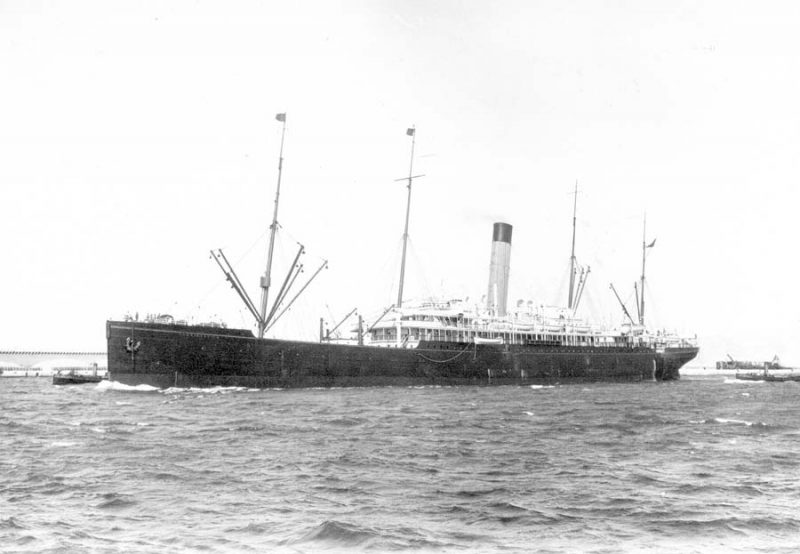
Design Of Leicestershire (2) and Warwickshire (2)
The surviving Bibby Line passenger and cargo ships were rebuilt after World War II, with most given only two masts as well as raked motorship funnels. Warwickshire (Yard number 733) was the first of the new pair of Bibby Line post-war vessels, and was given two masts and three pairs of posts for derricks to handle cargo into five holds and five hatches. Leicestershire (Yard number 745), on the other hand, was given only a raked foremast, complete with crow’s nest and a signal yard, and four pairs of posts. She had two dozen derricks of ten or five tonnes capacity, operated by sixteen Clark Chapman winches, with the addition of a heavy lift derrick of 35 tons capacity on the foremast. The five holds had a grain capacity of 545,462 cubic feet, bale capacity of 487,420 cubic feet, and with a refrigerated capacity of 1,720 cubic feet at the forward end of number four upper ‘tweendeck. The forward end of number five upper ‘tweendeck was reserved for bonded goods e.g. spirits. The hulls of the pair had seven bulkheads including the collision bulkhead and had well rounded cruiser sterns.
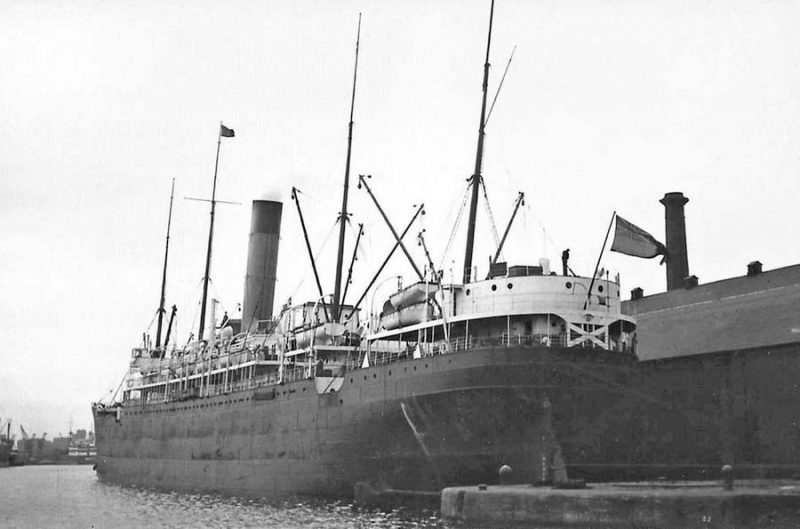
The hulls of the pair were part electrically welded, and had deep tanks for the carriage of vegetable oils or latex, or water when in ballast, and two decks with a part third deck in their hulls named as Upper, Middle and Lower Decks, as well as two decks of passenger accommodation and public rooms in the ‘midships structure named as Bridge Deck with Promenade Deck above. The structure above Promenade Deck had a long row of deep window openings, the forward half being plated to full depth and was fitted with closely spaced vertical sliding windows. Steel bulwarks were fitted across the front of Boat Deck, which had the cabins for the four Navigating Officers as well as the doctor, two radio officers and the cadet. The Master had his suite of rooms at the aft end of the navigating bridge. Passenger accommodation was provided for 76 persons in 28 single and 18 double berth cabins on the Bridge Deck, and 4 three berth cabins on the Upper Deck to starboard of number three trunked hatchway. The bathrooms and lavatories were grouped centrally, while two of the cabins had en-suite facilities. The public rooms were as follows:-
The Dining Room was located on Upper Deck and was entered via a foyer flanked by full length mirrors together with comfortable armchairs and coffee tables. Tables for 84 persons from four to nine diners, at a single sitting, were graced by the surrounding panelling in light cream coloured textured veneers relieved by Nigerian cherry beeding and a number of hunting scene paintings. Mahogany chairs had blue hide upholstery with the curtains matching these colours, while decorated table lamps and bulkhead lamps added to the illumination of the dish type ceiling lights. The pianist at the baby grand piano provided music to accompany the enjoyable meals in this very attractive room.
The Lounge was located at the forward end of Promenade Deck, and again had a grand piano in a corner, with comfortable mahogany armchairs and settees in green and gold upholstery grouped around low coffee tables. There were also four writing tables at the aft end, with gold damask curtains around this very attractive room.
The Smoke Room was abaft the Lounge and just to the rear of number three trunked hatch. The wall panelling was in oaknut and elm burr, and the floor was of marble, while the furniture was walnut with rust hide upholstery. The bar had a teak front and was at the forward end of the room, with again hunting scene paintings as decoration.
The Verandah Café was abaft the Smoke Room but separated from it by a portable partition of large opening doors and windows that converted the space of these two rooms to increase their comfort, particularly in the tropics. Light cane chairs and tables gave the pleasant feeling of this open, airy room.
The Children’s Playroom was also on Promenade Deck ‘midships and easily reached from the passenger cabins below on Bridge Deck. Bright colours, rocking horses, sand pits, and wall figures of animals and birds kept the offspring of passengers happy on the long voyages to and from Burma. There was also an open air swimming pool at the aft end of Promenade Deck with plenty of games provided such as skittles, deck tennis and quoits.
The Hospital and Hairdressing Salon were located on Bridge Deck, near to the accommodation for four nurses, two stewardesses, and the Purser. Six European catering staff and the carpenter were also allocated cabins on this deck, but the Indian crew were located in the poop along with the engine room greasers, boatswain, donkeyman and stewards in bunked beds. The messrooms and cooking areas for these essential crew were nearby on the poop, with the house on the poop deck having the three Stothert & Pitt capstan motors, lavatory spaces, three separate galleys, and a hospital and adjoining bathroom.
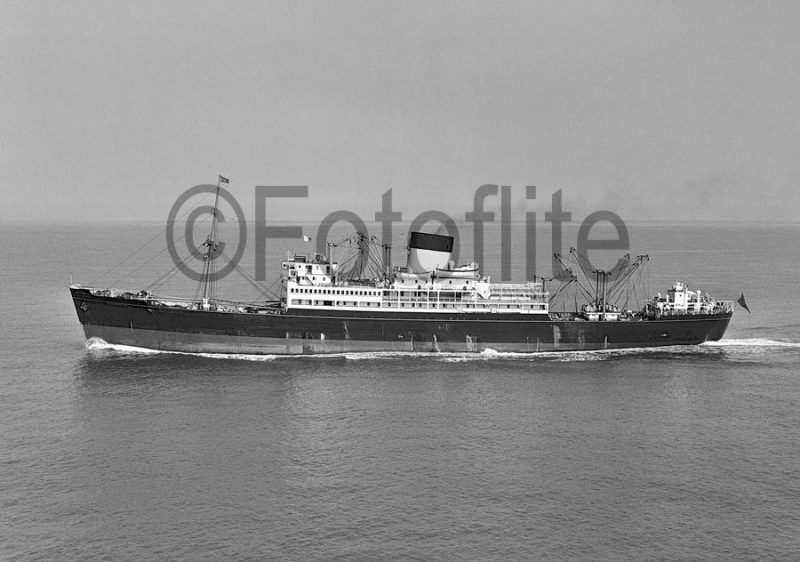
Warwickshire and Leicestershire were turbine powered by three double reduction Pametrada steam turbines of 7,000 shp at a propeller speed of 105 rpm, with steam raised at 455 psi by two watertube boilers, to give 18.4 knots on flat out trials at 7,700 shp and 15.5 knots service speed. The astern working speed was eight to nine knots. They had dimensions of overall length 498.0 feet, moulded beam of 60.3 feet, depth of 32.2 feet, and a draft of 27.6 feet. The fo’c’stle was of length 54.0 feet, and the ‘midships bridge deck of 190.0 feet, with a poop deck of length 43.0 feet. They were the first steamers and single screw ships for Bibby Line for 27 years. The gross tonnage was measured at 8,908 grt, with the deadweight working out at 9,589 tonnes. The navigating bridge was equipped with the latest equipment including direction finders, electric signalling device, Sperry Mark XIV gyroscope with two repeaters, three magnetic compasses, Kelvin Hughes radar and echo sounder, Chadburn’s engine room and docking telegraphs, and a radio telephone. The radio room was installed by the Marconi International Marine Communications Company with an Oceanspan main transmitter, Mercury and Electra receivers, and a Vigilant auto-alarm.
The pink funnels with a black top and the hulls with a very thin yellow band and pink boot topping gave the new pair an unmistakable Bibby Line image. The raked funnel of Warwickshire was slightly taller than that of her sister. The derrick post tops served as ventilators for the holds, and there were four lifeboats, two each to port and starboard of the raked funnel. The double bottom incorporated a duct keel and had compartments for the carriage of fuel oil, fresh water and ballast water, the latter also carried in the fore peak and after peak. The fo’c’stle provided space for a lamproom, carpenter’s shop, an awning store, boatswain’s stores as well as the Clarke Chapman windlass and Stothert & Pitt motor rooms. The galley consisted of a kitchen, pantry, scullery, bakery, butcher’s shop, milk room, silver and glass room, and a bar. These were all within easy reach of the Dining Room on the Upper Deck and various mess rooms.
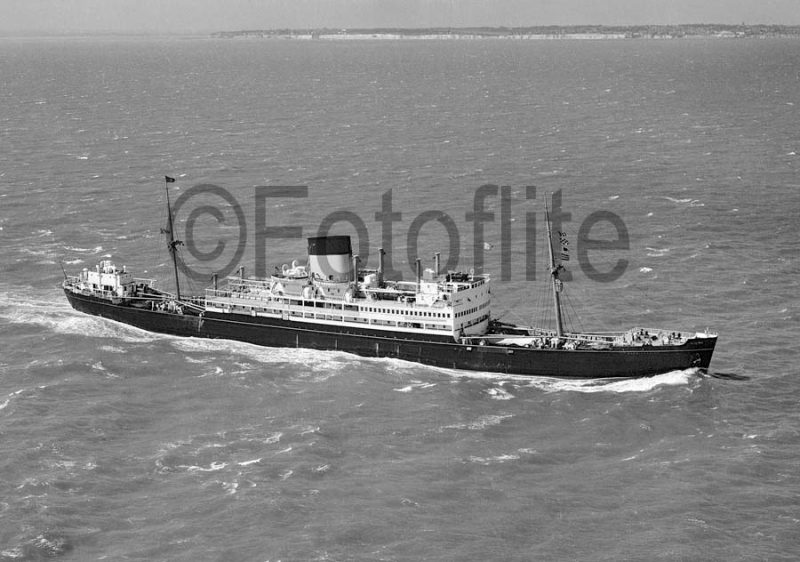
Warwickshire (2) and Leicestershire (2) In Service
There were now five Bibby Line passenger ships on the Rangoon service, the new pair plus Staffordshire (2) of 1928, Worcestershire (2) of 1931, and Derbyshire (2) of 1935, the latter trio having undergone extensive refits after strenuous wartime duties. Warwickshire had been launched on 14th August 1947 by the wife of a director of a major charterer of Bibby Line ships, Mrs. C.C. Barber, and sailed on her maiden voyage to Rangoon from Birkenhead on 5th September 1948. Leicestershire was completed in December 1948, and made her maiden voyage from Birkenhead to Rangoon on 21st January 1949. On her return voyage, she collided at Suez with the tanker Regent Jaguar of the Regent Oil Company. She was carrying rice and rice products, teak and hardwoods, bran, rubber and tobacco, with a large number of bales of cotton loaded at Port Sudan on the Red Sea.
Leicestershire spent the whole of 1952 on charter to British India Line for their East African services, as both sisters faced declining service to Burma throughout their careers due to its independence, and long periods on charter to liner operators. By 1955, the trade to Rangoon was down to one sailing every three weeks, with long waits swinging at the buoys in the Yangon river before a berth could be obtained to load rice, teak and hardwoods. The wait could on occasion be months, and the service became uneconomical after the Suez crisis of 1956, with the ships facing an extra four thousand mile voyage around South Africa to Burma. The fortunes of Bibby Line were kept afloat by its troopships on charter to the British Government.
In 1959, the Burma Five Star Line, later Myanmar Five Star Line (MFSL), was established and immediately admitted to the Far East Liner Conference, the share of the trade for both Bibby Line and ‘Paddy’ Henderson being drastically reduced. By 1961, only three Bibby Line ships remained on the Burma service in Herefordshire of 1944, and the passenger and cargo pair under review in this article. The charter market for first class cargo-liners was very strong at this time, and a quartet of cargo-liners in Shropshire (3), Cheshire (3), Yorkshire (3) and Lancashire (3) of 7,200 grt (9,500 dwt) as open shelterdeckers, and 8,900 grt (12,200 dwt) as closed shelterdeckers, came into service during 1959/63. They each made their maiden voyage on the Burma trade but were then long term chartered to worldwide liner operators as they were very versatile and fitted with a fifty tonne heavy lift derrick on their foremasts.
Steel Brothers, the Rangoon agents of Bibby Line, closed down in 1962 and was replaced by the State owned Thihi Shipping Agencies. Finally, in 1965 the passenger service to Rangoon from the U.K. ended, and Warwickshire (2) and Leicestershire (2) were unsuitable for charter work and were withdrawn from service at the beginning of that year and put up for sale. They were duly sold to Typaldos Brothers of Greece for conversion into ro-ro ferries.
The Henderson Line service to Burma was heavily reduced in 1965 and finally ceased in June 1967 when the Suez Canal was blocked by the Arab/Israeli War, and the last ships Bhamo, Pegu and Yoma were transferred to the ownership of the Guinea Gulf Line and Elder Dempster Ltd. Henderson had thus disappeared into the Elder Dempster fleet of Ocean Transport and Trading Ltd., and arrangements were made with Bibby Line in 1968 to handle all of the Henderson Burma requirements, and their Gloucestershire of 8,640 dwt, built as Cingalese Prince in 1950, closed out the Burma service when she sailed from the West Float in Birkenhead for Burma in 1971. Bibby Line closed their activities in Burma, which had been the mainstay of their business for over eighty years.
Typaldos Brothers Of Greece
The Typaldos Brothers began their ferry business in 1932 with very small craft operating in the Saronic Gulf out of Piraeus. After the German occupation of Greece ended in 1944, the fleet was renewed in 1948 with the purchase of the small Norwegian fjord steamer Dronningen renamed Ionion and built back in 1893, again for Saronic Gulf services. Larger ferries and passenger liners were then purchased, some laid up for as much as two years before their conversion for Greek coastal work. These included:-
Princess Charlotte built back in 1908 by Fairfields for Canadian Pacific, with her three funnels reduced to one during her refit, renamed as Mediterranean.
Princess Adelaide built back in 1910 by Fairfields for Canadian Pacific, renamed Angelika.

Princess Alice built back in 1911 on the Tyne by Swan, Hunter and Wigham Richardson Ltd., renamed Aegeon.
The frigate Teti was purchased in 1955 and completely rebuilt into a passenger ferry, renamed Adriatiki.
Associated Humber Lines was established in 1935 for near Continental services out of Hull, and sold Melrose Abbey, built in 1929, to Typaldos Brothers, and was rebuilt without much care to her appearance and renamed Criti for service to Crete from Piraeus.
Tasmanian Steamers Ltd. sold their Taroona, built in 1935, to Typaldos Brothers for conversion to serve Piraeus, Istanbul, Beirut and Port Said from Venice, renamed Hellas.
Local Saronic Gulf services also used Elli from 1960, and she had been built in 1929 in Italy with six different names before purchase.
Santa Paula and Santa Rosa of 9,100 grt with accommodation for 290 passengers were purchased from Grace Line as twin screw turbine powered liners built by the Federal Shipbuilding and Dry Dock Company at Kearney in New York in 1932. They were renamed Akropolis and Athinai respectively, and after little alteration, began their service during the winter of 1961/62 engaged on Mediterranean services.
Two seaplane tenders, built in 1944 and 1946 for the U.S. Navy, were purchased in 1962 and altered out of all recognition into white hulled smart small cruise ships in 1963/64 named Mykonos and Rodos. A corvette was purchased in 1961 and renamed Lemnos, and a submarine chaser was purchased in 1962 and renamed Hydra.
The French cross Mediterranean ferry Sidi Okba, built by Whites of Cowes in 1947, was purchased after a disastrous fire in Marseille in early 1963 and renamed Mediterranean II to replace Mediterranean of 1908. She was later renamed Electra for Greek and Mediterranean cruising.
The SNCF ferry Londres of 2,404 grt, launched in 1940 and used by Germany in World War II as a minesweeper in the Kiel Canal approaches, was purchased and towed from Southampton in the first week of 1964 to Piraeus. She was renamed Sofoclis Venizelos and converted into a motorship for service to Heraklion and Rhodes from Piraeus. She was destroyed by fire at Piraeus on 15th April 1966 and beached nearby and then broken up.
One of my favourite liners of all time, the beautiful twin funnelled Colombie of 1931, used by French Line on Caribbean services until her withdrawal at Marseille in March 1964, was purchased, her second funnel having been removed in 1949. She was renamed Atlantic and then Atlantica by Typaldos Brothers and, after having a sideport cut into her hull for loading cars, she entered service from Venice.
Two twin screw turbine powered Mediterranean vessels, Ville d’Oran of French Line built in 1936, and her former running mate Ville d’Alger also dating from 1936, were purchased in 1965 and renamed Mount Olympos and Poseidon respectively.
Typaldos Brothers thus had a big fleet of over twenty ferries and cruise ships operating in the Greek and Mediterranean areas when they purchased the last pair of Bibby Line passenger and cargo-liners.
Conversion of the Bibby Line Pair to Greek Ferries
Leicestershire (2) and Warwickshire (2) were sold to join the large fleet of the Aegean Steam Navigation Company of Typaldos Brothers of Piraeus in November 1964, and made the long voyage out to the Perama shipyards in March and April 1965 where they were converted into car and vehicle ferries renamed Heraklion and Chania respectively. A large hole was cut in their ‘midships port and starboard sides to fit a ro-ro ramp for access to the car decks for a large number of cars and 35 trucks. The masts and pair of posts with their associated derricks and masthouses were removed, and a light tripod navigation mast fitted on top of the navigating bridge. The passenger accommodation was retained and updated for the short run to Crete from Piraeus.
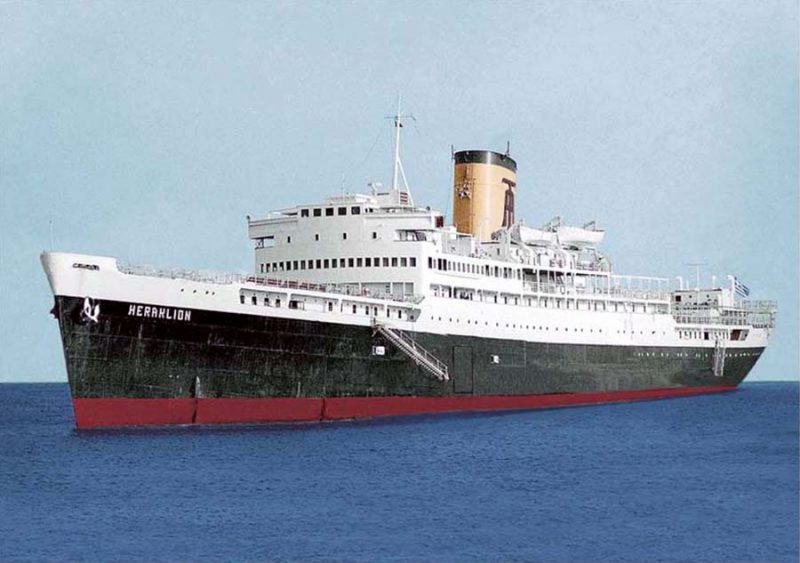
Heraklion sailed from Souda Bay on Crete at 2000 hours on 7th December 1966 after a two hour delay ordered by her Master as winds in the area were gusting up to Force 9 on the Beaufort Scale. She had also loaded a refrigerated truck full of oranges which was not properly lashed down to cope with the severe wind conditions. She managed to get halfway to Piraeus, but just to the south of Falkonera Island, the orange laden refrigerated truck began banging on the ‘midships loading door. This eventually gave way with the truck and the oranges plummeting into the sea, and allowing huge waves to flood the ship. Heraklion sank at around 0200 hours on 8th December 1966 in position 36° 52′ North, 24° 08′ East.
The SOS was repeated twice but the Greek Ministry of Mercantile Marine could not handle the necessary communications, and the port authorities at Piraeus, Syros and other islands could not help due to lack of equipment. This left ships and aircraft in the immediate area to come to the rescue of passengers and crew in the water. These ships and aircraft were:-
- The Greek ferry Minos, 24 kilometres from the scene, but did not receive the SOS.
- A Greek frigate was at Syros and took three to four hours to get underway.
- Three Greek Air Force aircraft took off from Eleusis with the first arriving at 1000 hours.
- Two Royal Navy ‘Ton’ class minesweepers, Ashton and Leverton, started picking up survivors at 1000 hours.
- Four American destroyers, Lawrence (DDG-4), Bordelon (DD-881), James C. Owens (DD-776) and Strong (DD-758) and other members of the U.S. Sixth Fleet took part in Search and Rescue (SAR) operations.
However, there were only 46 survivors (16 crew and 30 passengers) out of a total of 263 persons onboard (73 crew and 191 passengers), leaving 217 people drowned. One of the dead was the grandson of Robert Baden-Powell, the Chief of the British Scout movement, named as Michael Robert Hall King aged 24 years.
The long history of inherent stability in all ro-ro passenger and freight ferries began with the sinking of Heraklion. Typaldos Brothers were found guilty by the Greek Government investigation into her loss on a number of counts, including:-
- Twelve of their fifteen ships had failed ship inspection under international law.
- No drills for abandoning ship had taken place during the voyage.
- A delay was made before the SOS signals were sent out.
- The ship’s officers did not participate in the organisation of rescue work.
Haralambos Typaldos, the owner of the company, and Panayotis Kokkinos, general manager, were both found guilty of manslaughter and of faking documents, and served long prison sentences. Warwickshire, renamed Chania after her conversion to a ro-ro ferry, was serving opposite Heraklion on the daily Piraeus to Crete run, but was immediately laid up after the disaster until January 1971 when she was renamed Sirius, and was broken up at Aspropyrgos in 1980. Three other Typaldos ferries, Hellas, Athinai and Rodos were also laid up for twenty years after the sinking, after failing to attract buyers. The completely rusted hull of Athinai was used in 1978/79 as a floating set for the film ‘Raise the Titanic’ and was renamed Titanic for the duration of the filming. A stone sculpture ‘The Monument of the Hand’ was erected to the memory of the dead in Chania harbour in the 1990s.
Bibby Line Diversification
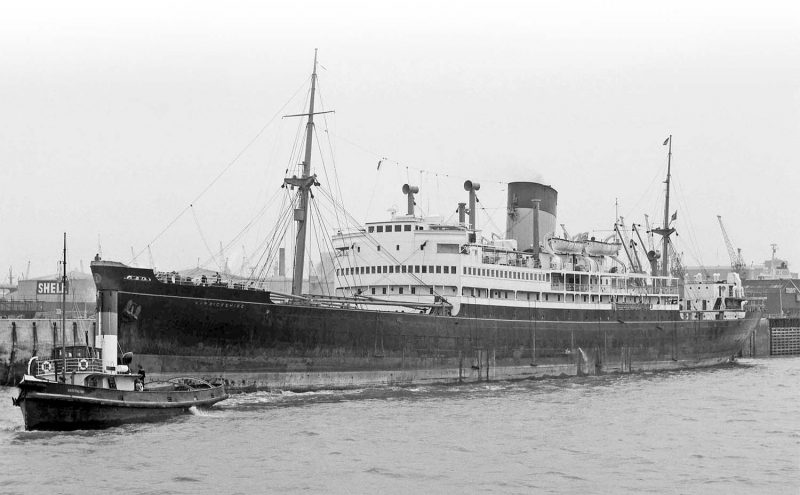
Bibby Line celebrated its 200th anniversary in 2007, John Bibby (1775-1840) having founded the company, which is claimed to be the oldest independently owned deep sea fleet in the world today. After the loss of the Burma trade in 1971, the company diversified into large bulk carriers and ore/oil carriers utilised in the British Seabridge Group. Liquid petroleum gas (LPG) tankers, and the takeover of the Bristol City Line in 1971 led to an entry into deep sea container shipping, as Bristol City Line had a one third interest in Dart Container Line. The Bibby Line fleet fell from twenty ships in 1975, which included the tanker Yorkshire of 112,744 dwt and completed in two halves on the Tyne in 1975 and joined together in dry dock, to only seventeen ships in 1980.
The fleet in 1980 comprised the car carriers Berkshire, Cheshire and Oxfordshire built on the Wear in 1970, the general cargo ships Herefordshire, Lancashire and Warwickshire built on the Wear in 1972 and 1967, the container ship Dart Atlantic built in 1971 on the Tyne, the car carrier Northamptonshire built on the Clyde in 1969 and acquired in 1977, the Panamax bulk carriers Cambridgeshire of 71,600 dwt, Dorsetshire of 80,800 dwt, the Capesize bulker Derbyshire, and the liquid petroleum gas (lpg) tankers Devonshire built in 1974, Lincolnshire built in 1972, Wiltshire built in 1968, Hampshire built in 1974, and Staffordshire built in 1977, as well as the Aframax tanker Yorkshire.
The ore/oil carrier Derbyshire disappeared without trace on 9th September 1980 in the South China Sea with the loss of all 44 people onboard. She had been completed in June 1976 as Liverpool Bridge by the Furness yard at Haverton Hill on Teesside, and had been renamed Derbyshire in 1978. She sailed from Seven Islands in the St. Lawrence on 11th July 1980 with a full cargo of 165,000 tonnes of iron ore concentrate pellets, and berthed at Cape Town on 6th August. She radioed that she was hove to in a typhoon on 9th September when 230 miles south east of Okinawa, and is presumed to have foundered shortly afterwards. She was the largest British built and owned ship ever lost at sea, with formal inquiries into her loss continuing for some years.
Ship management began in 1984, with the first client being the Shipping Corporation of Trinidad and Tobago Ltd. Two methanol tankers were managed in Harold La Borde and Trinidad and Tobago of 14,325 dwt. They had eleven tanks with a large horizontal cylindrical tank on their decks, and had been completed by Sasebo Heavy Industries in 1983/84. They had dimensions of length 140.4 metres, moulded beam of 21.6 metres, depth of 11.41 metres, and loaded draft of 8.6 metres, with a service speed of fifteen knots from a six cylinder MaK diesel engine of 4,300 bhp manufactured by Ube Industries Ltd.
The good looking general cargo ships Herefordshire and Lancashire, built on the Wear in 1972, were sold off in 1982 as the last conventional ships in the fleet. The fleet in 1985 comprised five lpg tankers in Devonshire, Staffordshire, Hampshire, Lincolnshire and Wiltshire, with the tanker Yorkshire in use as a storage ship at Mubarek oil terminal, moving to Sharjah in the same capacity in 1988 until attacked by Iranian warships on 18th April 1988 and set on fire aft. She was sold badly damaged for breaking up at Alang, where she arrived on 28th August 1993.
Specialist ships e.g. North Sea oil supply vessels such as Bibby Marinia of 3,951 grt, six ‘floatel’ accommodation barges with the first pair on charter to the Ministry of Defence in 1983 for the Falklands garrison, and chemical tankers saw the fleet through to 1995 with five deep sea ships in Lincolnshire, Shropshire (V), Herefordshire (4), Staffordshire (3) and Cheshire (V). The oldest British shipowning company had survived where so many illustrious names have completely disappeared into the realms of maritime history, and was still family owned. The Tyne built LPG tanker Lincolnshire of 24,950 dwt served for thirty years in the fleet from 1972 to her sale in November 2002 to Indian shipbreakers at Alang.
Chemical tankers were then owned on charter to Stolt Tankers e.g. Stolt Cornwall, Stolt Kent and Stolt Durham, as well as the LPG tanker Lancashire of 22,800 dwt delivered in November 2002 by the Hyundai yard in South Korea, and the LPG tanker Oxfordshire of 22,950 dwt completed in 1995 by Mitsubishi in Japan and sold to Exmar of Belgium in 2005. Two bulk carriers were then completed by the Yangzhou Guoyu yard in China as Shropshire of 56,811 dwt in February 2009 and Cheshire of 56,598 dwt in March 2012. These two deep sea ships form the present fleet, along with the Singapore registered bunkering vessel Mumbai of 6,188 dwt. The latter vessel was built in China for the high seas and domestic bunker market trade and has been owned by Bibby Line since August 2011. The Bibby Line fleet has had the remarkable achievement in having had only eight Chairmen until the death of Sir Derek Bibby in 2002.
Postscript
Warwickshire (2) and Leicestershire (2) were the last passenger and cargo-liners in the Bibby Line fleet when they were sold off in 1964, the Burma trade continuing for a few more years until 1971 and having lasted for well over eighty years. The Bibby red houseflag with a centrally placed yellow family motif of a hand clasping a dagger was to be seen no more in Burma.
However, the Bibby Line fleet is still powering ahead today with three owned deep sea ships, and there are other Bibby Line Group companies, the group dates from 1989, operating such as Bibby Offshore with a fleet of five offshore support vessels including Bibby Polaris, Bibby Sapphire, Bibby Topaz and Normand Clipper. Bibby Marine offers flexible ‘floatel’ accommodation as an alternative to land based accommodation, as well as operating the specialist survey vessels Bibby Athena and Bibby Tethra. Bibby Distribution is a major logistics provider, with a big fleet of articulated and rigid lorries, as well as warehousing for the industrial, consumer products, paper and packaging, and food and drink sectors. Bibby Financial Services is a multinational corporation that provides invoice factoring, invoice discounting and business funding to small and medium sized enterprises (SME) in the manufacturing, transport, wholesale and recruitment sectors.

The Bibby Line fleet has owned over 250 ships of all types from sailing ships to container ships during their very long and distinguished history of over two hundred years. Most very famous British shipping names have completely disappeared into the realms of maritime history, but it is a great consolation that Bibby Line, and also the Hadley Shipping Co. Ltd. with a similar sized bulker fleet, continue to flourish. It is a very great pleasure for me to write about a British shipping fleet that is still very much in business, and I wish them every success in the future.




Comments
Sorry, comments are closed for this item